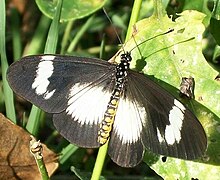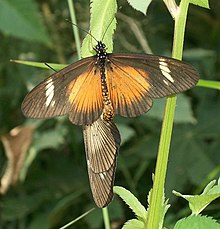Acraea esebria
| Dusky acraea | |
|---|---|

| |
| Acraea esebria form monteironis | |

| |
| Orange form male mating with female of another colour form | |
| Scientific classification | |
| Kingdom: | |
| Phylum: | |
| Class: | |
| Order: | |
| Family: | |
| Tribe: | |
| Genus: | |
| Species: | A. esebria
|
| Binomial name | |
| Acraea esebria Hewitson, 1861
| |
| Synonyms | |
| |
Acraea esebria, the dusky acraea, is a butterfly of the family Nymphalidae from southern and eastern Africa.

Description
The dusky acraea is a variable species, but the most common form is black with a white band across the forewing and a white patch on the lower forewing and on the hindwing.[1] There are a number of described morphs (with white, yellow or orange patches) including:
- f. ertli
- f. esebria
- f. protea (black with creamy-yellow patches)
- f. monteironis (black with white patches)
- f. jacksoni
The wingspan is 45–55 mm for males and 53–60 mm for females. Males and females both show the same range of colouration.[1]
Distribution
This species is found from the Eastern Cape of South Africa to Zimbabwe and in Mozambique,[1] Malawi, Zambia, southern Democratic Republic of the Congo (Shaba), Angola, Tanzania and eastern Kenya (east of the Rift Valley).
Life cycle
Eggs
The eggs are oval in shape.[2]
Larvae
The larvae feed on Urtica, Laportea peduncularis, Urera trinervis, Urera hypselodendron, Obetia tenax, Pouzolzia procridioides, Pouzolzia parasitica and Fleurya mitis.[3]
Adults
Adults are on wing year round but are more common in the warmer months,[3] from December to April.[1] These butterflies fly slowly in and around forests and feed from flowers.[1]
Gallery
-
Eggs hatching on Laportea peduncularis
-
Dusky acraea larva on human finger
References
- ^ a b c d e Williams, M. (1994). Butterflies of Southern Africa: A Field Guide. Southern Book Publishers. ISBN 1-86812-516-5.
- ^ Woodhall, S. (2008). What's that Butterfly?. Struik Publishers, Cape Town. ISBN 978-1-77007-486-6.
- ^ a b Woodhall, Steve (2005). Field Guide to Butterflies of South Africa. Cape Town, South Africa: Struik. ISBN 978-1-86872-724-7.
External links
- Die Gross-Schmetterlinge der Erde 13: Die Afrikanischen Tagfalter. Plate XIII 57 c form protea d amphiprotea, pseudoprotea, jacksoni, metaprotea, monteironis
- Die Gross-Schmetterlinge der Erde 13: Die Afrikanischen Tagfalter. Plate XIII 59 d inaureata
- Images representing Acraea esebria at Bold
- Acraea esebria at Pteron


